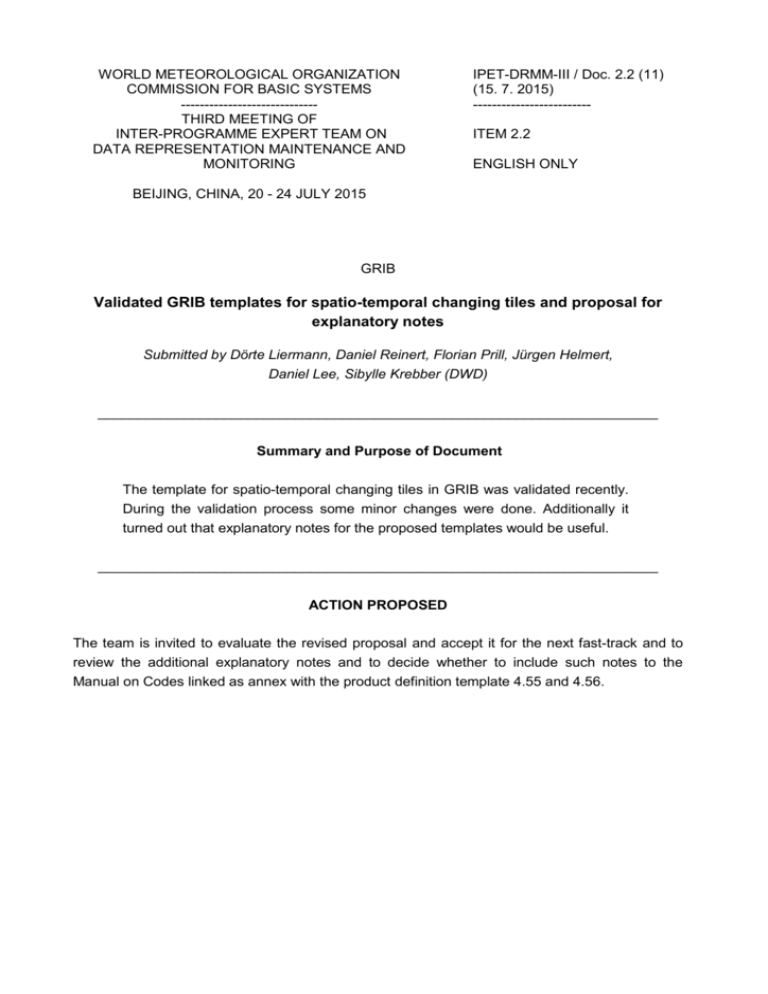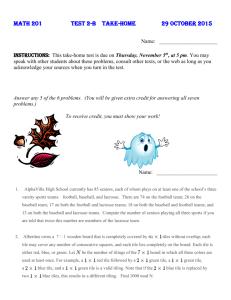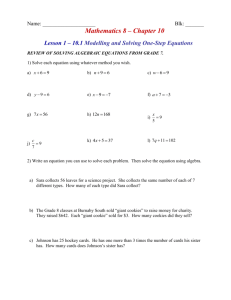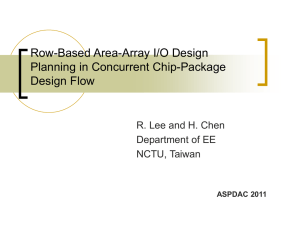Doc 2.2(11)
advertisement

WORLD METEOROLOGICAL ORGANIZATION
COMMISSION FOR BASIC SYSTEMS
----------------------------THIRD MEETING OF
INTER-PROGRAMME EXPERT TEAM ON
DATA REPRESENTATION MAINTENANCE AND
MONITORING
IPET-DRMM-III / Doc. 2.2 (11)
(15. 7. 2015)
------------------------ITEM 2.2
ENGLISH ONLY
BEIJING, CHINA, 20 - 24 JULY 2015
GRIB
Validated GRIB templates for spatio-temporal changing tiles and proposal for
explanatory notes
Submitted by Dörte Liermann, Daniel Reinert, Florian Prill, Jürgen Helmert,
Daniel Lee, Sibylle Krebber (DWD)
_______________________________________________________________________
Summary and Purpose of Document
The template for spatio-temporal changing tiles in GRIB was validated recently.
During the validation process some minor changes were done. Additionally it
turned out that explanatory notes for the proposed templates would be useful.
_______________________________________________________________________
ACTION PROPOSED
The team is invited to evaluate the revised proposal and accept it for the next fast-track and to
review the additional explanatory notes and to decide whether to include such notes to the
Manual on Codes linked as annex with the product definition template 4.55 and 4.56.
DISCUSSIONS
Operational users requested the addition of the total number of tile/attribute pairs so that they
can more efficiently allocate memory when reading GRIBs using the proposed template.
Therefore the proposal was adapted during the validation process to include this information.
Additionally, the octet for “Identification number of tile attribute” was removed, as it did not
provide any benefit.
PROPOSAL
Add the revised Product definition templates and the new entries in Code table 4.0 to the
Manual on Codes:
New entry in Code table 4.0 – Product definition template number
Octet No.
55
56
Contents
Spatio-temporal changing tiles at a horizontal level or horizontal layer
at a point in time.
Individual ensemble forecast, control and perturbed, at a horizontal
level or in a horizontal layer at a point in time for spatio-temporal
changing tile parameters.
Templates:
Product definition template 4.55 - Spatio-temporal changing tiles at a horizontal
level or horizontal layer at a point in time
Octet No.
Contents
10
Parameter category (see Code table 4.1)
11
Parameter number (see Code table 4.2)
12
Tile classification (see Code table 4.242)
13
Total number (NT) of tile / attribute pairs (see Note 2, 3)
14
Number of used spatial tiles (NUT) (see Note 2, 3)
15
Tile index (ITN ={1,…, NUT}) (see Note 2)
16
Number of used Tile attributes (NAT) for Tile ITN (see Note 2)
Attribute of Tile (see Code Table 4.241) ) (A ={A(1),…, A(NAT(ITN))})
17
(see Note 2)
18
Type of generating process (see Code table 4.3)
Background generating process identifier (defined by originating
19
centre)
Analysis or forecast generating process identifier (defined by
20
originating centre)
21 – 22
Hours of observational data cut-off after reference time (see Note)
23
Minutes of observational data cut-off after reference time
24
Indicator of unit of time range (see Code table 4.4)
25 – 28
Forecast time in units defined by octet 24
29
Type of first fixed surface (see Code table 4.5)
30
Scale factor of first fixed surface
31 – 34
Scaled value of first fixed surface
35
Type of second fixed surface (see Code table 4.5)
36
37 – 40
Scale factor of second fixed surface
Scaled value of second fixed surface
Notes:
(1) Hours greater than 65534 will be coded as 65534.
(2) The number of used Tiles (NUT) is the number of used different spatial tiles, defining
the cover structure of a point. As each of these tiles have one or more different tile
attributes A( NAT (ITN)), ( ITN=1,…,NUT), e.g. unmodified, snow-covered,…), there
are NT=
fields (that is, the total number of tile/attribute pairs,
defined in Octet 13) with indices( ITN, IAN ) with the following meaning (IAN = {1,…,
NAT(ITN)}):
1,1
First tile – first attribute (e.g. unmodified)
….
….
1,NAT(1)
First tile – NAT of first tile (last, e.g. snow-covered) attribute
2,1
Second tile – first attribute (e.g. unmodified)
….
….
2,NAT(2)
Second tile – NAT of second tile (last, e.g. snow-covered) attribute
.
.
.
.
NUT,1
NUT tile – first attribute (e.g. unmodified)
…. ...
NUT,NAT(NUT) NUT tile – NAT of last tile (last) attribute
A single tile/attribute index (ITN, IAN) with spatial tile index ITN (1,…,NUT) and
attribute A(IAN) with IAN=(1,…,NAT(ITN)) is represented in the template. All NT
partitions are linked by the normalisation formula, which states that the sum of all
partitions must be equal to a normalisation term (N=1 for fractions and N=100 for
percentage) on each point of the grid.
The fields "tile class" and "tile fraction" must be provided in order to obtain the tile
structure of each grid point. Please note that the field “tile fraction” is time-dependent
in the case of defined attributes, whereas the field “tile class” is not affected by
attributes (NT=NUT).
(3) For more information, see Attachment IV (Spatio-temporal changing tiles in GRIB) in
Part B of this volume (I.2 – Att.IV/GRIB 1 to x).
Product definition template 4.56 - Individual ensemble forecast, control and
perturbed, at a horizontal level or in a horizontal layer at a point in time for
spatio-temporal changing tile parameters.
Octet No.
10
Contents
Parameter category (see Code table 4.1)
11
12
13
14
15
16
Parameter number (see Code table 4.2)
Tile classification (see Code table 4.242)
Total number (NT) of tile / attribute pairs (see Note 2, 3)
Number of used spatial tiles (NUT) (see Note 2, 3)
Tile index (ITN ={1,…, NUT}) (see Note 2)
Number of used Tile attributes (NAT) for Tile ITN (see Note 2)
Attribute of Tile (see Code Table 4.241) ) (A ={A(1),…, A(NAT(ITN))})
(see Note 2)
Type of generating process (see Code table 4.3)
Background generating process identifier (defined by originating
centre)
Analysis or forecast generating process identifier (defined by
originating centre)
Hours of observational data cut-off after reference time (see Note)
Minutes of observational data cut-off after reference time
Indicator of unit of time range (see Code table 4.4)
Forecast time in units defined by octet 24
Type of first fixed surface (see Code table 4.5)
Scale factor of first fixed surface
Scaled value of first fixed surface
Type of second fixed surface (see Code table 4.5)
Scale factor of second fixed surface
Scaled value of second fixed surface
Perturbation number
Number of forecasts in ensemble
17
18
19
20
21 – 22
23
24
25 – 28
29
30
31 – 34
35
36
37 – 40
41
42
Notes:
(1) Hours greater than 65534 will be coded as 65534.
(2) See note (2) under product definition template 4.55
(3) For more information, see Attachment IV (Spatio-temporal changing tiles in GRIB) in
Part B of this volume (I.2 – Att.IV/GRIB 1 to x).
Add a new attachment:
ATTACHMENT IV
Definition of “tiles” with time-dependent attributes
How to code “tiles” with Templates 4.55 and 4.56
The land surface model is evolving and growing more complex. More complex descriptive
capabilities are needed to properly describe the representation of land cover types in state of the
art weather and climate models.
This includes the sub-grid scale tiling to represent surface heterogeneity. Each grid box with subgrid variability is divided into a number of tiles, each representing a single surface type.
The use of Template 4.53 and 4.54 for partitioned parameters implies that for every chosen
partition PN(1), PN(2), …, PN(NP) a GRIB message exists. All NP partitions are linked by the
normalization formula.
The GRIB code representation of this tile approach takes into account the possibility to encode
(1) only the dominating tiles, which could differ from grid box to grid box,
(2) tile attributes, considering that tile fractions can be modified according to code table 4.241 (e.g.
snow-covered)
Point (1) implies that every grid box has its own subset of tile classes from the land use table
Point (2) allows for the differentiation of tile attributes, the temporal component of this approach.
The fractions
of these N (dominant) classes and their attributes are subject to normalization
N
formula:
i 1
fi 1
In detail, the model grid box is regarded as consisting of a prescribed number of surface types
(tiles).
The fractional area of each tile is either given by the geospatial surface data or by one or more
prescribed tile attributes (e.g., snow-free and snow-covered). It is important to note that in
contrast to the geospatial surface data, the tile attributes according to code table 4.241 could be
time dependent.
Fig.1: Generation of the dominating tile structure for NUT=3 of a heterogeneous land surface. The outer
circle shows the fractional areas covered by the respective land cover classes for a given grid cell. The
inner circle shows the selected dominating tiles. Please note the rescaling of the fractional areas
performed in the inner circle.
Given the number of land-use surface types from the geospatial land-use data table in a
particular grid box, the approach recognizes the most dominant land-use surface types above a
prescribed threshold fraction (e.g. 5%) up to the number of used tiles (NUT). Two model grid
boxes always use the same number of tiles but could differ in the most dominant land-use
surface types (see Fig. 1, outer circles). The fraction of resulting NUT is always rescaled to the
total grid box area (see Fig. 1, inner circles).
For grid boxes with nearly homogeneous land-surface types the approach recognizes only the
single dominant type and the fractional area of the other used tiles is considered as zero (see
Fig. 2).
Fig. 2: Generation of the dominating tile structure for NUT=3 of a nearly homogeneous land surface of a
coastal region. In this example, area fractions smaller than 5% are not considered when selecting the
dominating tiles.
The tile attributes considered in this approach allow for a modification of the tile fractions, e.g. by
a temporal evolution of the snow cover (see code table 4.241– tile attributes). Therefore, a
subset of the land-use classes from the geospatial land-use data table can be considered for tile
attributes.
Fig. 3: Generation of the dominating tile structure for NUT=3 with tile attribute “snow-covered” of a
heterogeneous land surface, partly covered with snow. Dominating tiles are equipped with two attributes
where applicable: “snow-covered” and ”unmodified”. Shaded areas show the snow-covered tile fractions.
The tiles used in a particular grid box which belong to the attribute are then divided into fractions
of the attribute and fractions of the originating dominating tile (see Fig. 3).







